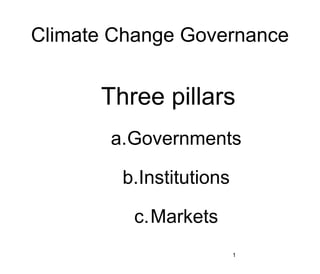Climate Change Governance
- 1. Climate Change Governance Three pillars a.Governments b.Institutions c.Markets 1
- 2. Climate Change Governance ŌĆó When one fails other compensates ŌĆó When one fails it either self corrects and evolves with new attributes. Or depends on the other for a change. ŌĆó The cycle should repeat it self. 2
- 3. Why we (consistently) Fail Institutional Failure ’üČ Participation ’üČ Sophistication / Time ’üČ Blame? Democracy? Inclusively? ’üČ Inequalities ’üČ Me first attitude! 3
- 4. Why we (consistently) Fail Government Failure ’āś Implementation ’āśTimely & Suitable policy intervention ’āś Representation ’āś Credibility 4
- 5. Why we (consistently) Fail Market Failure ’ü▒Transparency ’ü▒ Uniform trading platform / exchange ’ü▒ Pricing ’ü▒ Demand for Credits ’ü▒For E.g. Currently 60 % emissions of India is from Power, Steel, Aluminum, Cement, Paper & Fertilizers 5
- 6. Steps is CDM Inspiration ŌĆō Visit various URLs / Consultants - Search for Buyer / Partner - Cost & Benefit Analysis - Proceed with the following For Example 700 days from CDM registration to first CER issuance. 600 days from PIN to Registration. Average CER Spot Price is 12 Euros PIN / PCN & PDD Development Project Developers / Consultant Host Country Approval GOI / MOEF i.e. DNA Validation DOE Registration CDM EB Implementation Project Developers Monitoring Project Developer + DOE Verification DOE Certification CDM EB Issuance of CERs CDM EB 6
Editor's Notes
- #4: For Example 700 days from CDM registration to first CER issuance. 600 days from PIN to Registration






